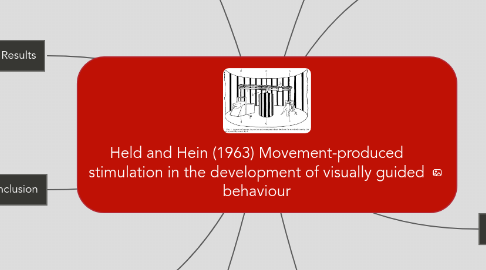
1. Procedure
1.1. X group
1.1.1. Reared in darkness from birth until...
1.1.2. Time in apparatus
1.2. Y group
1.2.1. Time in apparatus
1.3. Paw placement tests
1.4. Visual cliff tests
1.4.1. X group
1.4.2. Y group
1.5. When not in tests, kittens were with mother and litter mates
2. Results
2.1. Visual cliff task
2.1.1. Suggests
2.2. Paw placement
2.3. Blink response
2.4. P kittens after 48 hours in lit room
2.5. Pupillary reflex to light, tactual placing and visual pursuit
3. Conclusion
3.1. 'Normal' perceptual development
3.2. This doesn't seem to be due to
4. Evaluation
4.1. Controls and reliability
4.2. Controls and cause and effect
4.3. Ecological validity
4.4. Mundane realism
4.5. Generalisability
5. Evaluation in terms of animal ethics
5.1. Number of animals
5.1.1. Guideline - the number of animals should be kept to a minimum that still allows statistical analysis
5.2. Caging and social environment
5.2.1. Caging - housing in cages should not lead to overcrowding and increased stress levels
5.3. Protections from harm
5.3.1. There should be general protection from psychological and physical harm
5.3.1.1. You could argue
6. Context
6.1. Studying nature vs nurture
6.2. Previous research
6.2.1. Used animals deprived of...
6.2.1.1. Riesen and Aarons (1959)
6.2.1.2. Riesen (1961)
6.2.2. Used humans and rearrangement technique
6.3. Riesen/Hebb
6.3.1. Examples of associations that might be necessary for perceptual skills
6.3.1.1. To test
7. Aim
7.1. To investigate
7.2. Held and Hein suggest
8. Method
8.1. lab experiment
8.2. Participant Design
8.3. 'Kitten carousel' created
8.3.1. 2 roles for kittens
8.3.1.1. Active
8.3.1.2. Passive
8.3.2. Controls
8.3.2.1. Advantage
8.3.3. Apparatus
8.4. Independent variable
8.5. Tests of perception
8.5.1. Visually guided paw placement
8.5.2. Avoidance of a visual cliff
8.5.3. Blinking at an approaching object
8.6. Tests of other responses
8.6.1. Pupillary reflex
8.6.2. Reaction to paws being placed on table
8.6.3. Visual pursuit of a moving object
